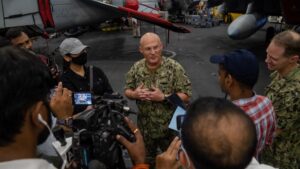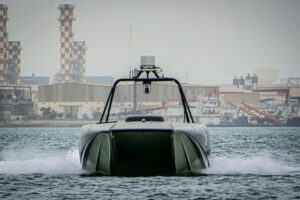Two Biden administration officials this week said there is a “huge potential” to expand AUKUS Pillar Two technology sharing and cooperation in the future.
While the U.S., U.K. and Australian governments announced an “optimal pathway
” to help Australia build and field its own nuclear-powered attack submarines under the AUKUS agreement in March, the agreement also includes a second set of non-nuclear submarine technology sharing called Pillar Two (Defense Daily, March 13).

Last year, a joint statement issued by President Biden, U.K. Prime Minister Boris Johnson and Australian Prime Minister Scott Morrison confirmed the AUKUS agreement will also include cooperation on non-submarine technologies like hypersonic and counter-hypersonic weapons, electronic warfare, cyber capability, artificial intelligence, quantum technologies (Defense Daily, April 5, 2022).
Speaking at a Center for Strategic and International Studies event on June 26, Chief of Naval Operations Adm. Mike Gilday was asked about the ability of more countries like New Zealand, South Korea and France to participate in that Pillar Two part.
“I think there’s huge potential to do that in selected areas. I think that’s where I would have began, instead of wholesale, you know, inviting nations to Pillar Two, I would look at certain areas where nations bring technology to bear that is going to make a difference, and that we have high trust and confidence that we can share that information back and forth,” Gilday said.
He noted most research and development is being done by industry rather than governments, so this kind of technology sharing aims to use that basis.
“That’s the intent of pillar two, is to leverage that and to hit the accelerator so that – I’ll speak for just the United States, DoD is sometimes very slow, in terms of how we transition new technology to actually fielding it. And so we’re trying to use, in some ways, Pillar Two to accelerate that significantly, so we can take disruptive technologies in some of those areas…and to get them on the table,” Gilday said.
Kurt Campbell, Deputy Assistant to the President and Coordinator for the Indo-Pacific, agreed and said other partners may ultimately participate based on their specific capabilities if it can be made practical.
“I do believe that there are going to be some areas where some allies and partners have some either direct or niche areas where they can assist in a larger endeavor. And that might be in hypersonics, that could be in cybersecurity, it could be in anti-submarine warfare, there are a number of areas that we will explore as we go forward. I think the key is going to be that, you know, what do you bring to the table? And are you able to do it in such a way that’s going to be practical and operational,” Campbell said.
Campbell emphasized the government wants to share practical efforts to enhance defense capabilities in the near term and not merely theoretical applications.
“We are in conversation with a variety of countries who are interested and, frankly, it goes far beyond just those countries [New Zealand, South Korea and France]. And we’re grateful for that, the fact that countries are interested in it is a positive, and we will explore those appropriately,” Campbell said.

He added that the U.S., U.K. and Australia have made clear that “under the appropriate circumstances, we would be prepared to work collaboratively with other partners who bring capacity to the challenge.”
Campbell confirmed AUKUS Pillar Two will not just be a club countries can just join, but a partnership where all the members will have to make the argument for what they bring to the table.
Gilday said while most of the current Pillar Two technologies the three countries are working on are classified, he confirmed AI and unmanned systems will be part of it.
The CNO also revealed the U.S., Australia and U.K. will jointly conduct an unmanned exercise that Australia will host in the fall. This will be on top of unmanned exercises the U.S. is testing by itself, in the Middle East with 5th Fleet’s Task Force 59 with regional partners, and more upcoming in South America.